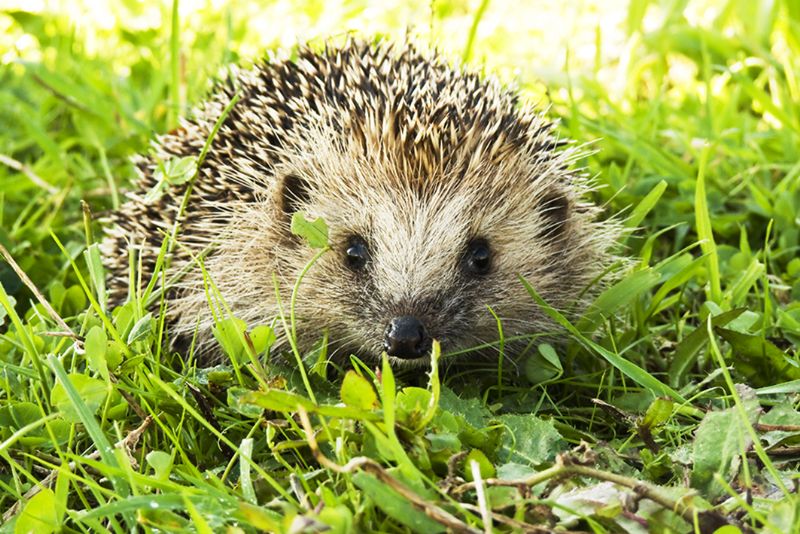- Home
- News, Articles & Reviews
We are hiring! Please click here to join our growing magazine delivery team in Gloucestershire!
Areas
Pets & Wildlife
Archive

Prickly garden friends
All Areas > Pets & Wildlife > Wildlife Matters
Author: Caroline Shelley, Posted: Sunday, 24th September 2017, 08:00
A snuffly nose, a brown face, shiny black eyes and prickles all over. It can only be one mammal: a hedgehog. As a nation we have a fondness for hedgehogs. Depicted in children’s literature by the likes of Beatrix Potter and Alison Uttley as friendly and loveable characters, it is perhaps no surprise that they were voted the UK’s favourite mammal in 2016.
Despite our fondness, however, hedgehogs are under threat. In the last ten years we have lost one third of our hedgehogs. This decrease in population is thought to be as a result of a number of factors, and more research is now underway to try to find out more. Rural hedgehogs face, amongst other things, threats from pesticides and destruction of hedgerows. Meanwhile urban hedgehogs face factors such as the loss of green garden space and the use of slug pellets in gardens.
Help hedgehogs access your garden
Fortunately, there is much we can do to help our prickly friends. Our gardens are extremely important to hedgehogs and by taking a few simple steps we can really help them. An adult hedgehog can cover 1-2km a night and their home ranges can be 10-20 hectares in size. This means a hedgehog does not visit just one garden a night but can cover a whole estate. The problem that exists for hedgehogs is fencing between gardens limiting access and therefore limiting their range. To help a hedgehog access your garden is very simple. Just cut a 13cm x 13cm hole in your fence and you can open up a whole new hedgehog habitat.
If you are lucky enough to have a hedgehog visiting your garden then it is fine to supplement their diet by leaving out food. You can do this with meat-based dog or cat food, unsalted, crushed peanuts, sunflower hearts or mealworms (although these should be limited). Do not give them milk as this makes them poorly, but do ensure water is available. A hedgehog’s natural diet includes small insects, amphibians, worms, caterpillars and slugs, so if you are a keen gardener then a prickly visitor is a great form of pest control and an environmentally friendly alternative to slug pellets.
Log piles provide a site for resting and hibernation
To further encourage hedgehogs, a pond can attract insects and amphibians that will in turn attract a hedgehog. It is important, however, to provide a slope (such as a wooden plank) so that a hedgehog can escape should it fall in. A log pile and/or leaving an area to grow untamed is great as well, as it provides a site for resting and hibernation.
Hedgehogs hibernate between November and mid-March so it is also a great idea not to tidy the garden borders until early spring. Plus with bonfire night approaching remember to check bonfires for hedgehogs who may consider a this a great place to hibernate.
Finally, take a look at www.hedgehogstreet.org. Here you can get great advice on helping hedgehogs and log sightings. Hopefully by making some small changes we can ensure a brighter future for our favourite mammal.Copyright © 2024 The Local Answer Limited.
Unauthorized use and/or duplication of this material without express and written permission from this site's author and/or owner is strictly prohibited. Excerpts and links may be used, provided that full and clear credit is given to The Local Answer Limited and thelocalanswer.co.uk with appropriate and specific direction to the original content.More articles you may be interested in...


© 2024 The Local Answer Limited - Registered in England and Wales - Company No. 06929408
Unit H, Churchill Industrial Estate, Churchill Road, Leckhampton, Cheltenham, GL53 7EG - VAT Registration No. 975613000You are leaving the TLA website...
You are now leaving the TLA website and are going to a website that is not operated by us. The Local Answer are not responsible for the content or availability of linked sites, and cannot accept liability if the linked site has been compromised and contains unsuitable images or other content. If you wish to proceed, please click the "Continue" button below:




